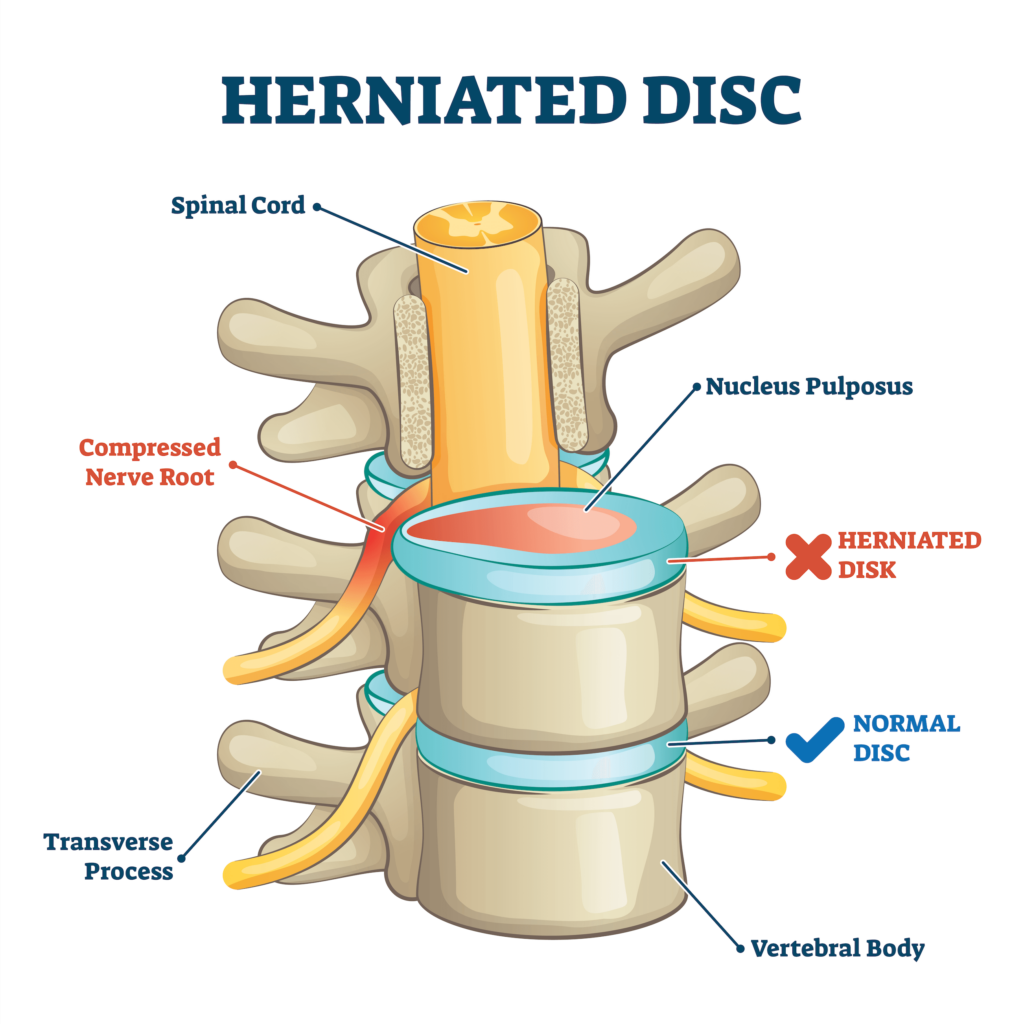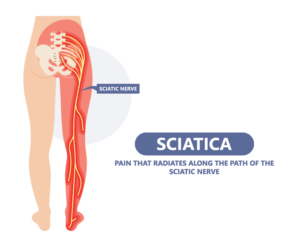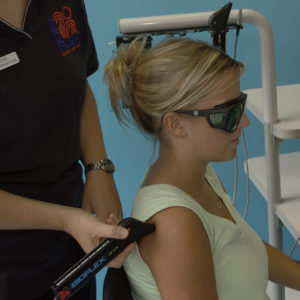If you’re reading this, you’re probably one of up to 40% of the population who suffers from sciatica pain, numbness, or tingling. This condition can range from irritating to downright debilitating. It doesn’t discriminate based on gender and rarely based on body type. Sciatica is one of those frustrating conditions that can go undiagnosed for long periods because it presents in a different area from where the problem originates.
Sciatica can affect every area of your life. We understand the agony – physical, mental, and emotional that can be caused by this unrelenting pain stemming from sciatic nerve irritation and inflammation. Patients have shared stories with us about how their sleep is affected, how they aren’t able to sit at their desks, how they can’t stand to do dishes, how they can’t play with their kids, and the list goes on and on. That’s just the physical limitations. When we lose sleep, our mental and emotional health is affected. When we’re not able to work or function in our daily lives, our sense of accomplishment diminishes. This type of chronic pain truly can impact every area of a person’s life negatively. It can be absolutely exhausting if you’re the one experiencing it every day.
Our noninvasive, drug-free technologies have proven time and time again to be effective in treating sciatic nerve pain. Too many times patients have come to us after being told that they need spine surgery, which we understand can be a very scary thing to hear. One woman, we’ll call her Judy, recalls the story of her neurosurgeon telling her that she needed spinal surgery at the age of 29. This was after receiving painful epidural injections every 6 weeks into her spine. She’d heard stories of friends and family going through spinal surgeries, only having to repeat the same surgery two or three years later and never really receiving any lasting pain relief. She knew surgery was not the route she wanted to take. With patients like Judy, we start by addressing the root cause of sciatic nerve pain. Let’s dig into what those causes could be for Judy and for you.
What is Sciatica?
Sciatica is a general term for pain, numbness, and/or tingling down a leg, often into the foot. These radiating symptoms are caused by irritation of a nerve root located in the lower back. The cause of this irritation can be a few things:
– Disc Herniation
– Foramina Narrowing, also known as Spinal Stenosis
– Piriformis Syndrome
Is Disc Herniation the Cause of Your Sciatica?
Disc herniation is the most common cause of sciatica. Sometimes referred to as a slipped disc, ruptured disc, or bulged/bulging disc – a herniated disc is best explained using the jelly donut analogy. Our spines are made up of stacked vertebrae, or small bones, that form the spinal canal. Each vertebra has a soft, cushion-like center. That’s the jelly in the donut of our analogy. When a disc becomes herniated, the soft, cushion-like center pushes through the casing, like the jelly leaking out of a donut. When this jelly leaks out, it pushes on the nearby nerve causing irritation.

The most irritating part about this, no pun intended, is that a herniated disc can be caused by just about anything. We’ve heard everything from, “I bent down to pick up a can of soup at the grocery store.” to, “I was digging holes all day because that’s what I do for work.” It can even be the luck of the hereditary draw. Studies have shown that degenerative disc disease can be hereditary and those with family members who suffer from disc degeneration may be predisposed themselves.
Sciatic pain caused by disc herniation typically increases with sitting, bending, standing, and lifting. The confusing part is that lower back pain is usually not as intense as the pain, burning, numbness, or tingling that radiates down one or both legs and into the foot. Your sciatic nerve runs all the way from your lower back down your leg and into your foot. So, when the soft jelly pushes out of the center of the vertebrae and onto that nerve, you can feel it throughout your entire leg and foot.
Is Foramina Narrowing/Spinal Stenosis the Cause of Your Sciatica?
In addition to those vertebrae that form our spinal canal, we also have even smaller openings called foramen. These tiny openings that shoot off from the sides of the vertebra can become smaller. The top vertebra makes the roof of the foramen canal, and the vertebra below creates the bottom. So, when joints and discs degenerate and move closer together, that space that nerves usually had to move around in becomes narrower. When they don’t have as much space, or when nerves are impinged upon due to narrowing or compression, this is called spinal stenosis, or foramina stenosis.
Similar to disc herniation, foramina narrowing/spinal stenosis doesn’t have any direct cause to which it can be attributed. Disc degeneration, age, and natural wear and tear have been cited as the most common causes. As far as risk factors go, experts in our community all agree that genetics, age, and overall health play a role. Being overweight, a sedentary lifestyle, or working in a manual labor job that requires you to engage in repetitive tasks could attribute to early disc degeneration and poor spine health.
Sciatica pain caused by foramina narrowing/spinal stenosis can be worsened when standing, walking, or laying on one side. In worst cases, patients can even lose bowel or bladder control. Many find relief when pushing a grocery cart or using a walker. For temporary relief, leaning or bending forward can create a bit more room for those nerves to move around within your foramen openings. This relieves the pressure/pinching on the nerves causing the irritation to almost release instantly. However, when you stand back up, the pain returns.

Is Piriformis Syndrome the Cause of Your Sciatica?
Perhaps the least scary of the three most common causes of sciatic nerve irritation is Piriformis Syndrome. While still causing the same intense, radiating pain throughout the leg and into the foot, Piriformis Syndrome is not typically related to a spinal deficiency or disc degeneration. Your Piriformis is a small muscle in your buttock that runs from the bottom of your spine to the top of your thighbone. Its purpose is to help you with rotating your hip and leg.
It should be no surprise that there isn’t a direct cause with which we can correlate this piriformis muscle irritation. However, just like disc herniation and foramina narrowing/spinal stenosis, some possible scenarios could be muscle tightening due to injury or spasm, nearby structure irritation (i.e. you hurt your hip or sacroiliac joint), or sitting for too long.
Sciatic pain caused by Piriformis Syndrome is directly related to the piriformis muscle’s proximity to the sciatic nerve. When it becomes irritated, you experience symptoms of sciatica. In some cases, the sciatic nerve even runs through the piriformis muscle, causing the pain to be that much more intense. For temporary relief, ice and heat therapy can be applied, as well as doctor-approved stretches and massage.
Conclusion – Know the Cause of Sciatica Before Beginning Treatment
Each of these three causes that we’ve talked about tends to be chronic. It’s even possible for one person to suffer from all three at once. If you don’t take away anything from this article, please take this – knowing the cause of your sciatica before you begin a treatment regimen is crucial to the success of your healing.
The good news is, whether you suffer from a herniated disc, spinal stenosis, or Piriformis Syndrome, there is hope. There are noninvasive, drug-free treatment options for each of these conditions. The best part is, here at LaserTech Pain and Back Relief Center, we help our patients find sciatic pain relief while avoiding back surgery! About 70% of the patients who come to see us come for back-related pain. We know back pain and we understand the impact it can have on your entire life. Our goal with each of our patients is to get to the root cause of your pain so that we can treat it correctly. Reach out today for a free consultation and get started on your journey to pain relief today!




